| Article ID | Journal | Published Year | Pages | File Type |
|---|---|---|---|---|
| 210052 | Fuel Processing Technology | 2013 | 15 Pages |
Thermal pyrolysis of plastic wastes in tubular reactor has been studied with Direct Computer Mapping based simulation methodology, combined with genetic algorithm. Degradation process was carried out in laboratory and pilot scale tubular reactor. The investigated pyrolysis temperature range was 465–545 °C, and raw material feeding rate was between 6 and 20 g/min. A dynamic simulation model has been developed based on a four-step degradation scheme, considering four cracking product fractions (gas, naphtha, middle distillate and heavy oil) and their hydrocarbon composition (paraffin, olefin and aromatic). A collaborating genetic algorithm was used for the identification of kinetic and stoichiometric model parameters. Having analyzed the identification results we concluded that some of the stoichiometric parameters, moreover all of the kinetic parameters and vapour/liquid phase ratios were independent from the reaction parameters, however they depend on the quality of raw material. The temperature and feeding rate dependency of the model were considered by two calculated parameters (pLiq, pAro). According to the investigations, the rate determining factor of the degradation process is the effectively utilized enthalpy resulting from the heat transfer through the wall of the equipment. The simplified dynamic simulation model can support the scale-up procedure of the pyrolysis technology.
► Pyrolysis of wastes was studied with Direct Computer Mapping based simulation. ► The depolymerization of plastic wastes has been realized in a tubular reactor. ► Dynamic simulation model has been developed based on a four-step degradation scheme. ► A genetic algorithm was used for the identification of kinetic model parameters.
